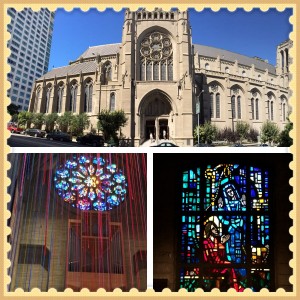I am back with a new article, I have been out of commission for a bit with this crazy back pain, so I am sharing a article and photo from Natchez Mississippi. My mother just visited The Trinity Episcopal Church in Natchez, MS and sent me some awesome photos so I thought I would share this with you. Its a lot of information but I found it to be very interesting hope you will too. The stained glass piece is actually is in 3D. I hope to go see this myself and maybe this will inspire you to visit also. Hope you enjoy this article.
The message of the 1890s Resurrection Angel window on the north side of the Trinity nave relates directly to its 1960s counterpart on the opposite side of the church where Jesus addresses the sisters Mary and Martha of Bethany. Following this incident with Jesus, when Martha went out to meet him after the death of her brother Lazarus, Jesus’ response to her included this phrase, inscribed in the base of the Resurrection Angel window:
“I am the resurrection and the life, saith the Lord: He that believeth in me, though he were dead, yet shall he live.” John XI:25
Above this inscription, in the main body of the window, an angel stands before the empty sepulcher (tomb). With one hand the angel holds a palm branch, the Roman symbol of victory that was transformed by the Christian story into a complex indicator of martyrdom and glory. Many images of Christian saints throughout history carry palms to indicate their death as martyrs. Of course palms also remind viewers of Jesus’ triumphant entry into Jerusalem at the beginning of Holy Week; in the Episcopal tradition, the celebratory fronds of Palm Sunday will be burned to create the ashes to mark the foreheads of the faithful at the beginning of the following Lent to remind them of their mortality.
With the other hand, the window angel points upward to heaven where the women visiting the tomb will be able to see Jesus again. The gesture may also be one of reassurance to the frightened women at the empty tomb. From the earliest accounts in Genesis of Abraham’s encounters with God’s messengers, their effect on those they meet is often terrifying, so their first words are often, “Fear not.”
The artist of the Trinity window has provided a traditional white-robed angel in the form of a winged figure, though none of the gospel accounts makes any reference to wings. But wings have throughout history been depicted on angels, seraphim, cherubim, and on the symbols of the four evangelists as indicators to the viewers of their divine mission.
The Trinity angel hardly seems terrifying in the Old Testament sense. He is more tastefully tame, with his handsome Grecian profile, sculptural three-dimensional folds in his robe, and neatly hewn marble sepulcher, framed by a pair of columns topped with classically carved capitals of acanthus leaves. A similarly classical border of acanthus and lotus surrounds the heraldic cross at the top of the window.
This is one of two windows in the Trinity nave attributed to the workshop of Louis Comfort Tiffany, the most acclaimed American stained glass artist at the turn of the twentieth century, noted for the monumental classical elegance of his figured pieces, the multicolored luminescence of his glass, and for his technique of layering and sculpturing the glass itself – all of which are clearly visible in the Trinity window.
Interestingly, though, the composition relates less closely to other Resurrection Angel windows installed by Tiffany in American churches than it does to an 1862 drawing in the Tate Gallery, London, for a church window in Brighton, England designed by noted English artist and designer William Morris. The drawing shows a remarkably similar empty sepulcher and hand gestures, though the angel in the Morris drawing is seated.
This window was dedicated to the Glory of God and in loving memory of George W. Koontz (1816-1876) and Mary Roane Koontz (1827-1895). The quote below the window is appropriate to a memorial dedication; it is the opening line of the Prayer Book service for Burial of the Dead in both Rite I and II. The window’s image is a reminder and a comforter that departed loved ones no longer reside in any earthly box but have obtained the ultimate freedom and joy in heaven above.

 October 29th, 2020
October 29th, 2020 




